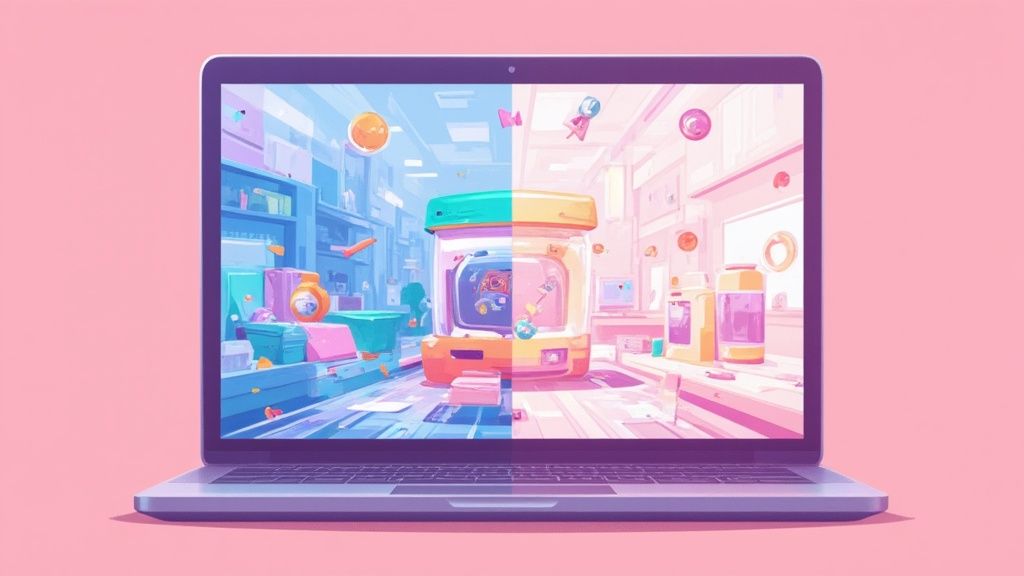Let’s be honest, trying to remove background from photos used to be a massive headache. It meant firing up complicated software and preparing for a long, tedious process. Manually tracing around objects was incredibly slow and, more often than not, the results were anything but the clean, professional look you needed for marketing or e-commerce.
Why Old Photo Editing Methods Are Obsolete
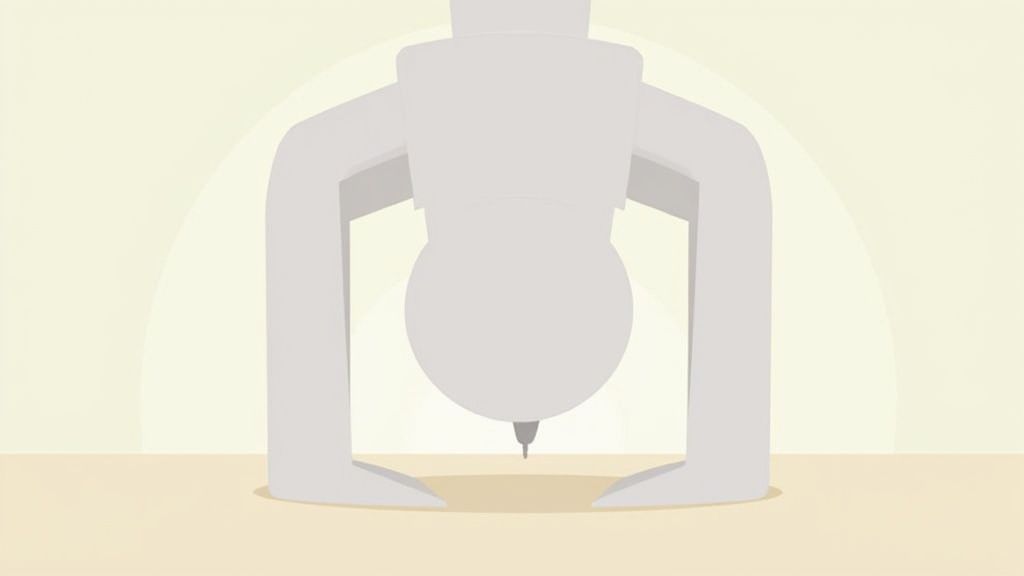
If you’ve ever spent what feels like an eternity zoomed in at 300%, meticulously clicking around wisps of hair or the intricate edges of a product with the Pen Tool in Photoshop, you know the struggle. It was a frustrating, pixel-by-pixel battle that often ended with a slightly jagged or unnatural-looking cutout.
This old-school method created a huge bottleneck for so many people. You either had to invest serious time learning advanced editing skills or shell out the money to hire a professional. For a small e-commerce store with a hundred new products to list, that just wasn't sustainable. It stalled product launches and turned the simple act of creating a social media ad into a major project.
The Modern Solution Is AI
This is where AI-powered tools like ProdShot have completely changed the game. Instead of hours of manual labor, you get a crisp, perfect cutout in a matter of seconds. This isn't just about making things faster; it's about making professional-grade photo editing available to anyone, no matter their technical background.
This isn't just a minor update—it's a fundamental shift in how we create visuals. The market reflects this, with the global background removal software space valued at around USD 1.5 billion in 2024 and projected to soar to USD 5.2 billion by 2033. That explosive growth is all about the massive demand for great-looking images in online retail, advertising, and content creation. You can find more data on this expanding market to see just how big this trend has become.
To really see the difference, let’s break down how the old and new methods stack up.
Manual vs AI Background Removal
| Metric | Manual Removal (Photoshop) | AI-Powered Removal (ProdShot) |
|---|---|---|
| Time Investment | 5-30+ minutes per image, depending on complexity. | 5-10 seconds per image. |
| Skill Requirement | High. Requires expertise with tools like the Pen Tool, masks, and channels. | Low. Just upload the image and click a button. |
| Consistency | Varies by user and image. Prone to human error. | Extremely high. The AI delivers consistent results every time. |
| Cost | High software subscription fees plus potential outsourcing costs. | Affordable, often with free tiers or pay-as-you-go options. |
| Handling Complexity | Difficult and very time-consuming for hair, fur, or transparent objects. | Handles complex edges with remarkable accuracy and speed. |
The table makes it pretty clear. While manual editing still has its place for highly artistic work, for the vast majority of day-to-day business needs, AI is the smarter, faster, and more efficient choice.
The core benefit of AI isn't just automation—it's empowerment. It hands creative control back to business owners and creators, eliminating the technical hurdles that once stood in their way.
Real-World Impact on Your Workflow
So, what does this actually look like in practice?
Picture this: you're an Etsy seller launching a new line of handmade jewelry. In the past, editing all those product photos would have eaten up your entire weekend. Now, you can process the whole batch during your lunch break.
Or think about a marketing team facing a tight deadline. They can whip up polished, eye-catching graphics for a social media campaign in minutes instead of hours. The AI removes all that friction, freeing you up to think about the bigger picture—your creative strategy, your marketing message, and growing your business. It's a completely new way to work.
How AI Actually Sees and Removes Backgrounds
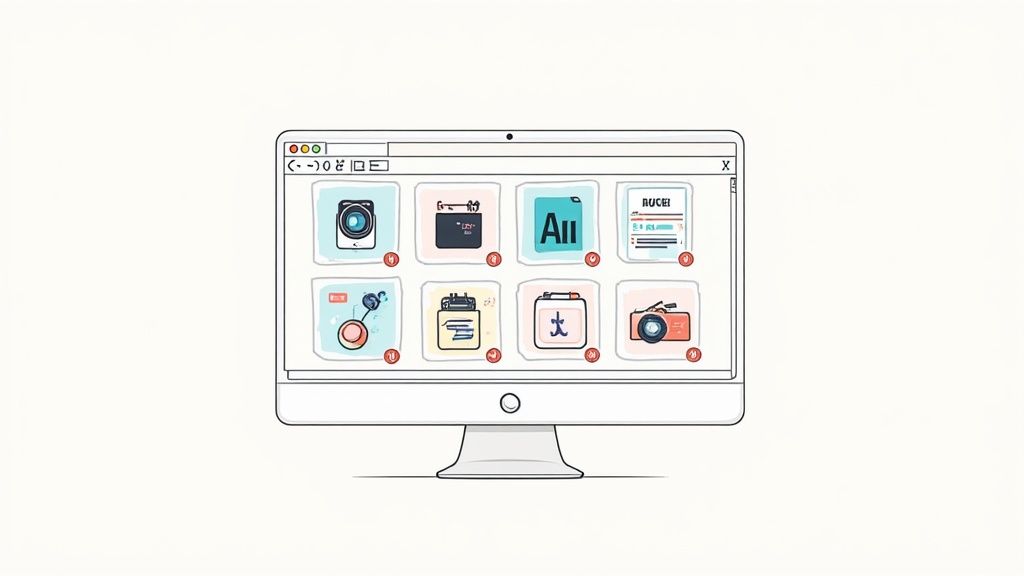
It might feel like a bit of digital magic, but what's happening behind the scenes is even more impressive. When you use an AI tool to remove a background from a photo, you're relying on a deep-learning process called semantic segmentation.
Think of it this way: the AI has been "trained" on a massive library of millions of images. In this library, every single pixel has been painstakingly labeled as either "foreground" (the main subject) or "background." Through this intense training, the AI learns to recognize common patterns, telltale edges, and the contextual clues that separate a person from the scenery behind them.
The Brain Behind the Operation
The core of this technology is a set of algorithms called neural networks, which are modeled after the way our own brains process information. They don't just see a random collection of colored dots; they learn to identify the subtle differences between a wisp of hair and the leaves on a tree, or the negative space between a chair’s legs and the floor beneath it.
This is exactly why modern AI can handle the tricky, time-consuming details that used to give graphic designers headaches.
The AI isn’t just looking at pixels—it’s interpreting the relationships between objects in the photo. It makes an educated guess about where the subject ends and the background begins, and it does so with remarkable precision, even with a busy background.
This ability has completely changed the game, turning a meticulous manual task into something that happens in seconds. Advanced tools can now navigate fine hair, transparent objects, and soft, fuzzy edges with a level of accuracy that was once unimaginable.
This same core technology doesn't just stop at removal. It's also what powers our https://prodshot.net/ai-product-photo-generator, which can create entirely new, realistic scenes from scratch.
The impact of this kind of AI goes far beyond just editing photos. If you're curious about how it's changing other fields, check out these fascinating AI's applications in digital marketing.
Making Your First Perfect Cutout with ProdShot
Alright, let's get our hands dirty. Seeing an AI background remover work its magic for the first time is one of those "aha!" moments. It really clicks just how much time you're about to get back. With ProdShot, the whole thing is boiled down to a refreshingly simple process that feels more like a quick drag-and-drop than a tedious editing session.
You don't need to worry about complex layers, selection tools, or feathering edges. The idea is simple: give the AI your image and let it do the hard work. Whether you're prepping a product shot for a Shopify listing or isolating a new team headshot, the first step is always the same.
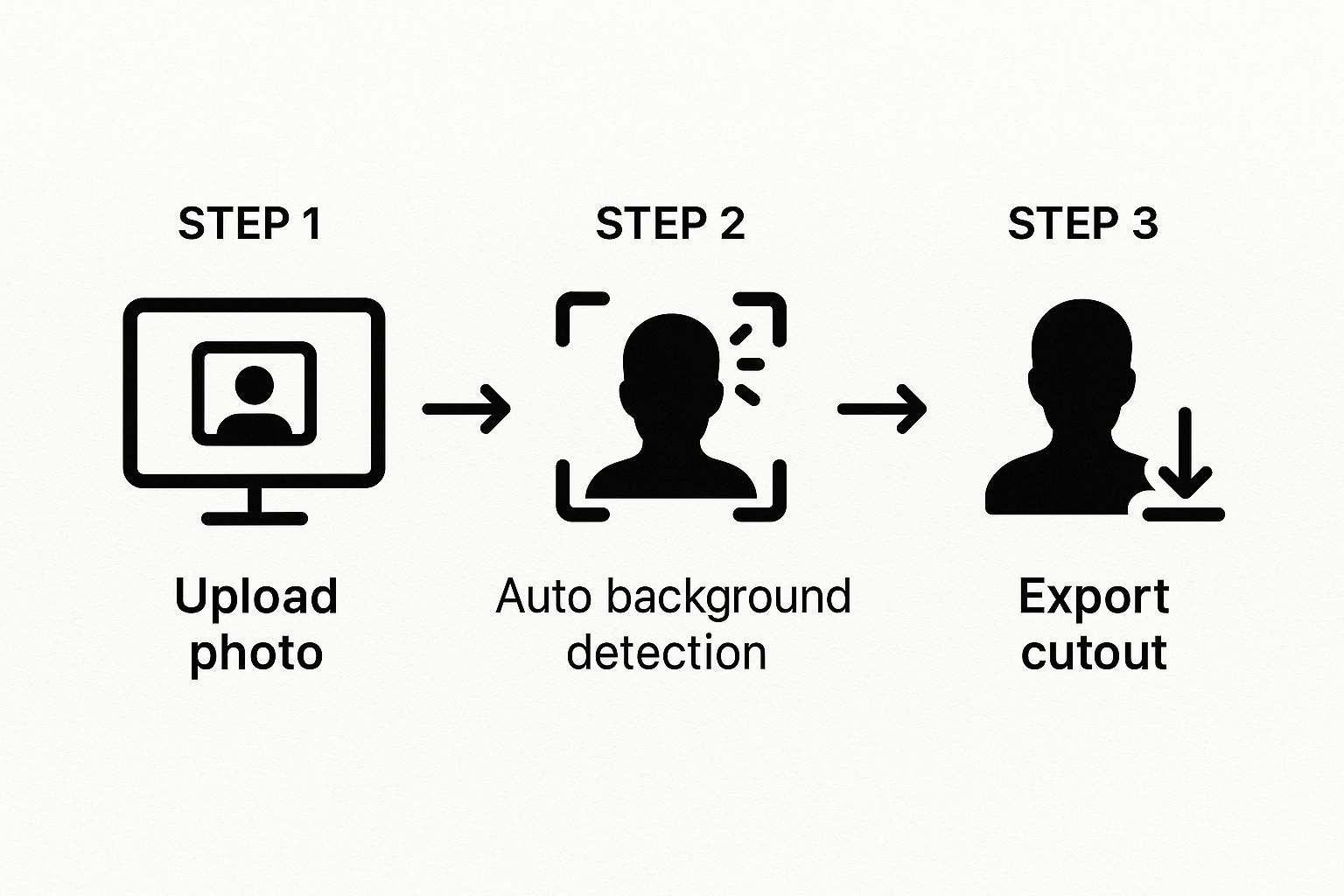
This workflow is all about speed and simplicity—getting from a cluttered photo to a clean, usable asset in seconds.
The Initial AI Pass
The moment you drop your image in, ProdShot’s AI is already analyzing it. It scans the pixels to figure out what’s the subject and what’s just background noise. In a few seconds, you'll see a preview of your object floating on a transparent background. There’s nothing to configure here; it’s all automatic.
For a good 80% of photos I run through the tool, this first pass is perfect. If you start with a decent photo—good lighting, clear subject—the AI usually nails it on the first try.
That's the benefit of a tool built for one job. It's not trying to be a full-blown photo editor; it's designed to give you a professional-grade cutout, instantly.
Refining and Saving Your Image
Now, the AI is good, but it's not always psychic. For tricky images with complex edges or weird shadows, you might need a tiny touch-up. ProdShot includes some basic refinement tools for this, but I've found I rarely have to use them. Maybe a small bit of a shadow got left behind—you can just erase it and you're done.
Once you’re happy with the result, it's time to export. You have a couple of practical options:
- Transparent PNG: This is my go-to. It saves the image with no background, making it incredibly versatile. You can drop it onto your website, into a marketing graphic, or over a video without any white box.
- Solid Color Background: You can also add a clean background right in the editor. A classic white or grey background is perfect for creating uniform product shots for marketplaces like Amazon or Etsy.
The entire workflow is designed to be frictionless. From upload to download, it's just a few clicks. If you're curious to see everything it can do, you can check out the full ProdShot platform and see how it slots into your own projects. What used to be a mind-numbing task is now a quick, almost satisfying, part of the creative process.
Getting Pro-Level Results from Your AI Background Remover
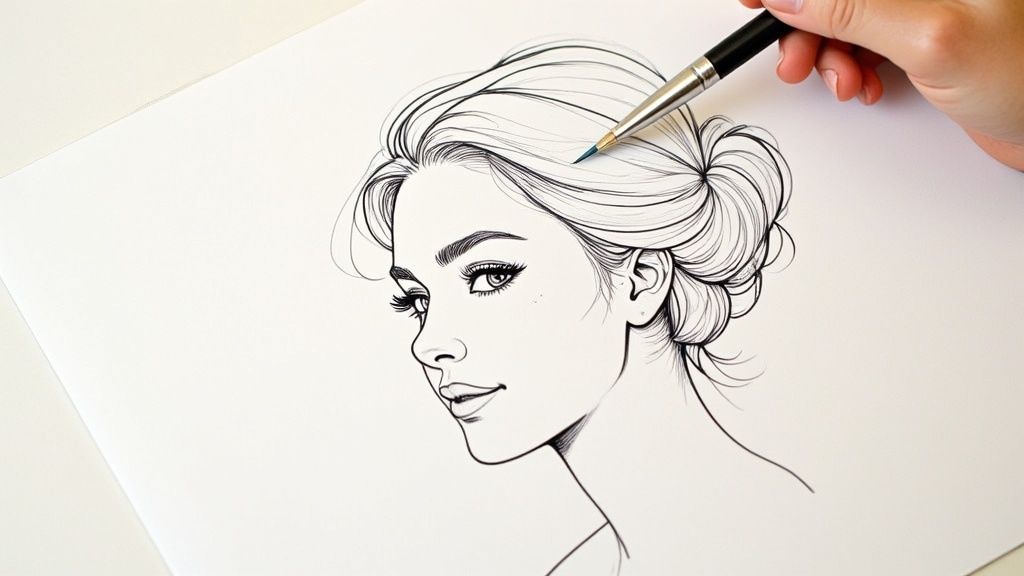
While AI tools like ProdShot make it incredibly easy to remove a background from a photo, a little prep work can take your results from good to absolutely perfect. The old saying holds true here: garbage in, garbage out. The better your starting photo, the better the final cutout will be.
Think about it from the AI's perspective. A well-lit photo where your subject stands out clearly from its surroundings is a dream scenario. It gives the algorithm a clear path to follow. On the other hand, blurry edges, heavy shadows, or a subject that melts into the background can throw it for a loop. If your product is dark, shooting it on a black backdrop is just asking for trouble. A few seconds of adjustment on set can save you a ton of editing headaches later.
A Quick Crop Goes a Long Way
Before you even think about uploading, do a quick crop. Seriously. Just by trimming away all the extra noise in the frame, you help the AI zero in on what actually matters—your subject. This is a game-changer for busy lifestyle shots where you need to pull one person or object out of a chaotic scene.
Imagine you have a photo of a model showing off a new pair of earrings, but the background is a bustling street. By cropping in tight on her head and shoulders, you’re essentially telling the AI, "Hey, focus on this." It dramatically reduces the risk of the tool getting confused and grabbing a piece of a passing car or a building by mistake.
I see this all the time: people upload a low-resolution photo and then wonder why the cutout looks pixelated. Always, always start with the highest-quality image you have. You can't create detail that isn't there in the first place.
The All-Important Final Step: Exporting
Once the AI has done its thing and you have a beautiful cutout, how you save it is critical. To keep that background transparent, you have to export the file as a PNG. If you save it as a JPEG, you’ll lose all your hard work—the software will just fill the transparent areas with solid white.
Saving as a PNG gives you total flexibility for what comes next:
- For E-commerce: You can drop the product onto a pure white background for that clean, uniform look on your Shopify or Amazon storefront.
- For Marketing: Easily place your cutout into a social media graphic or a digital ad without any clunky white boxes around it.
- For Design Work: Layer your subject seamlessly onto any new background, whether it's for a client presentation or a website hero image.
Following these simple tips will help you nail every single cutout, making sure your images are polished, professional, and ready for anything.
Putting Your Clean Images to Work
Once you’ve easily removed the background from your photos, the real fun begins. This isn't just a simple editing trick; it's a powerful asset that opens up a whole new world for presenting your products and brand. Think of it as the foundation for creating polished, high-converting visuals for every platform you use.
For anyone running an e-commerce store, this is a total game-changer. Suddenly, that project to create a clean, consistent product grid on Shopify or Amazon isn't a week-long headache. You can pump out professional-looking images that meet marketplace standards in just a few minutes, making your listings look instantly more trustworthy and appealing. Once you have those perfectly cut-out images, the next step is putting them to work. If you're selling on Amazon, for example, knowing how to use those visuals for boosting your Amazon conversion rate is what turns great photos into actual sales.
Supercharge Your Marketing Efforts
It doesn't stop at your storefront. These clean images are incredibly flexible marketing tools. Imagine a marketer needing to drop a perfectly isolated product into a new social media ad, an email campaign, or even a last-minute presentation slide. It's done in seconds.
This kind of speed means you can launch campaigns faster and create more dynamic content without having to wait on a design team for every little tweak. You’re not just editing photos anymore; you're creating opportunities on the fly. And when you need to take your visuals even further, our product photo editing services can handle the more advanced work.
By turning background removal into an instant, automated step, you reclaim hours of valuable time. This efficiency allows you to focus on strategic tasks like marketing, customer engagement, and business growth.
The demand for this kind of tech is exploding. In fact, the image background remover market is projected to hit around USD 500 million by 2025. This growth is all driven by the non-stop need for high-quality visuals in both e-commerce and marketing.
Got Questions? Let's Talk AI Background Removal
Jumping into AI-powered tools always comes with a few questions. Even if the process is simple, you want to know you're doing it right. I've heard them all, so let's walk through some of the most common things people ask when they start to remove the background from photos.
Can AI Really Handle the Tricky Stuff?
This is probably the number one question I get. "What about wispy hair? The little fuzzy bits on a sweater? The gaps between a bicycle's spokes?" People are rightfully skeptical because, for years, these details were the stuff of nightmares for manual photo editing.
And the answer is, for the most part, a resounding yes. The AI models we have today aren't just looking for simple outlines; they've been trained on millions of real-world images. This deep learning helps them understand context—what's hair, what's fabric, and what's just empty space.
Now, a super blurry or poorly lit photo can still trip up any tool, human or AI. But for a reasonably clear shot, modern AI can produce clean, crisp cutouts around complex edges that would have taken a skilled designer hours to trace with the Pen Tool. It's genuinely impressive.
What’s the Best File Format for a Transparent Background?
This one’s crucial. You've just isolated your subject perfectly, but if you save it in the wrong format, all that work goes to waste.
You'll want to save your image as a PNG (Portable Network Graphics). Think of PNG as the go-to format for anything needing a see-through background. It's specifically built to handle transparency, so the area where you removed the background stays empty. This lets you drop your product onto a new color, a lifestyle shot, or a graphic without any ugly white boxes.
A quick pro-tip: Never save a transparent image as a JPG. The JPG format doesn't support transparency. It will automatically fill in any transparent areas with a solid color (usually white), completely defeating the purpose of removing the background.
Should I Use an Online Tool or Desktop Software?
Finally, there's the big debate: an easy-to-use online tool versus a powerhouse program like Adobe Photoshop. Honestly, the "best" choice really comes down to your workflow and what you need to accomplish.
-
Online AI Tools (like ProdShot): These are all about speed and convenience. There's no software to install, you can access them from any computer, and you get fantastic results in seconds. They're perfect for e-commerce sellers, marketers, and anyone who needs clean cutouts without the technical overhead.
-
Desktop Software: The big appeal here is total manual control. If you need to perform complex composites or have a very specific artistic edit in mind, a program like Photoshop gives you every tool imaginable. But that power comes with a steep learning curve and, often, a monthly subscription fee.
For the vast majority of tasks—especially in e-commerce and marketing—a dedicated online tool gives you the ideal mix of professional-grade results and pure simplicity.
Ready to see it in action? Give ProdShot a try and discover how fast you can create stunning, professional images. You can remove backgrounds and generate entire product scenes in just a few clicks. Get started for free at ProdShot.

